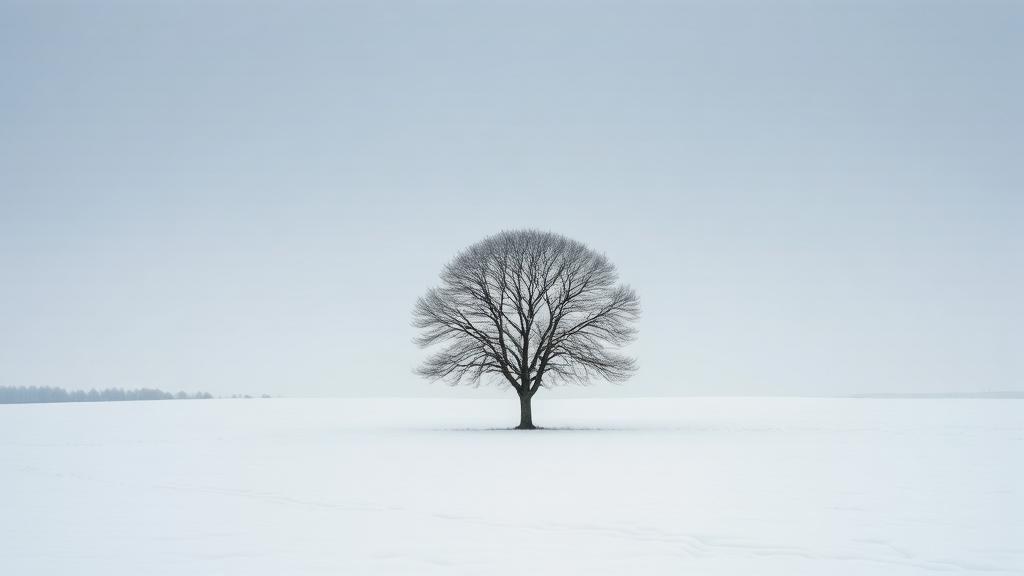This is part 4 of of a series
Simple Composition Tricks to Instantly Improve AI Images with Prompts
More Simple Composition Tricks to Instantly Improve AI Images Using Prompts
Intermediate Composition Tricks to Instantly Improve AI Images Using Prompts
Intermediate Emotional & Narrative Composition Techniques for AI Images Using Prompts
Simple Composition Tricks to Instantly Improve AI Images with Prompts: Camera Angles Edition
Simple Composition Tricks to Instantly Improve AI Images with Prompts: Perspective Edition
Simple Composition Tricks to Instantly Improve AI Images with Prompts: Color & Mood Edition
Simple Composition Tricks to Instantly Improve AI Images with Prompts – Light & Shadow Edition
Simple Composition Tricks to Instantly Improve AI Images with Prompts: Texture & Detail Edition
Introduction:
This guide introduces intermediate-level composition techniques that add emotional impact, visual psychology, and narrative depth to your AI-generated images. All techniques here can be achieved using text prompts only – no special add-ons or external tools required. We’ll explain each concept in clear, plain language, with practical prompt examples you can copy. Each example includes tips on why it works and how to tweak wording for Hi-Dream (Full, Dev, Fast, Community Mixes), Flux (Dev, Schnell, etc.), and Stability AI’s models (SD 1.5, 2.1, SDXL, etc.). The goal is to help you move beyond basic framing and into more nuanced, story-driven visuals, all through clever prompting. Let’s dive in!
Leading Negative Space (Emotional Isolation & Distance)

What It Is: Negative space is the empty or open area around your subject. Using a lot of empty space in a scene can evoke feelings like loneliness, freedom, or contemplation . By deliberately leaving large blank or simple areas, you “isolate” the subject and draw the viewer’s eye to it. This technique often creates an emotional tone – for example, a small figure surrounded by emptiness can feel very solitary or introspective. It’s a proven composition trick in photography to amplify a subject’s importance and mood through emptiness 1 .
How to Prompt It: To get negative space in AI images, describe a scene where your main subject is very small or off to one side, with a vast plain or sky around it. Emphasize emptiness and simplicity. For example: “A lone tree stands in the middle of a vast, empty snow-covered field under a blank gray sky.” This prompt tells the AI to create one small tree and a whole lot of featureless field and sky. The phrase “vast, empty… under a blank sky” strongly suggests negative space (lots of emptiness) around the tree. In HiDream models, you may get a beautifully minimalist, dreamy scene by default – Hi-Dream tends to produce clean, artistic compositions, so a simple prompt about emptiness can work well. In Flux (Dev or Schnell), which excels at photorealism, you might get a very realistic lone tree photo with a blurry horizon. Flux is pretty good at prompt accuracy, so phrases like “vast empty field” usually translate to plenty of negative space. Stable Diffusion 1.5 or 2.1 might sometimes try to add unwanted details in the emptiness (old SD models often want to fill the frame). To avoid that, be explicit: words like “empty,” “vast,” “open space,” or even “surrounded by empty space” in your prompt can help the model leave areas blank. In fact, adding something like “small figure, surrounded by empty space” can prevent the subject from being cropped or accompanied by random objects 2 . SDXL (and newer SD3) handle composition better, but it’s still wise to emphasize the isolation.
Tips & Troubleshooting: Because we aren’t using tools like ControlNet, pure prompting for subject placement is hit-or-miss. If your AI keeps centering the subject or adding stuff in the background, try these tips:
Use positioning words: e.g. “off-center”, “in the distance”, “at the bottom corner”. Sometimes this guides the model to not center the subject.
Emphasize emptiness: Reiterate emptiness with phrases like “vast expanse of sky,” “nothing but clouds around,” “blank backdrop,” etc. This repetition increases the chance the model leaves space blank.
Negative prompts: You can also use the negative prompt to discourage clutter. For example, negative prompting “extra objects, people, text, buildings” might help keep the scene clean. (All our focus is on text prompts – negative prompt is a part of that, so it’s okay to use.)
Model nuances: Hi-Dream Full tends to follow prompts well for artsy compositions – you might get very smooth minimalist results. Hi-Dream Fast or Community mixes might add more texture or objects unless told not to, so lean into simplicity in your wording. Flux Dev is quite literal; if it’s adding things, you may need to explicitly say “empty horizon” or such. Stability’s older models might double subjects if there’s too much empty space (the dreaded extra head phenomenon when it doesn’t know what to do with blank areas). If that happens, simplify the prompt and try again, or add “solo” or “single [subject]” to reinforce that there should be only one subject.
Why It Works (Visual Impact): Negative space works because our eyes immediately latch onto the one thing in a sea of nothing. It gives the subject “room to breathe,” making it stand out powerfully 1 . The emptiness also conveys mood – quiet, loneliness, or calm – depending on context. In your AI-generated image, this can create a striking, emotional shot. Viewers might feel the solitude of that lone tree in the field or the smallness of a character against a huge empty landscape. In narrative terms, negative space can symbolize isolation or focus attention on a subject’s emotional state without distractions.
Rhythm & Repetition with Variation (Pattern Breaks & Visual Rhythm)
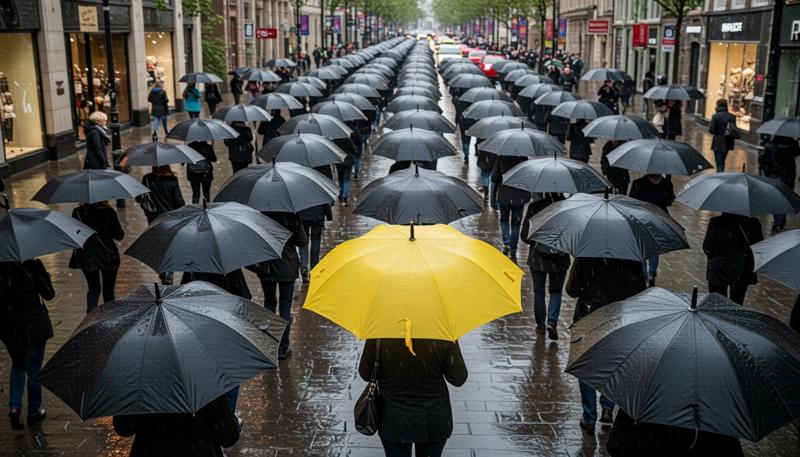
What It Is: Rhythm in visual composition means creating patterns or repeating elements that guide the eye across the image. Repetition can make an image feel orderly or dynamic, and introducing a variation or break in the pattern creates a point of emphasis. In other words, when a pattern is interrupted, that spot instantly grabs attention 3 . This technique is about using similar elements multiple times (shapes, objects, figures, etc.) and then having one element differ – in color, shape, position, or missing entirely – to add drama or focus.
How to Prompt It: To leverage repetition in prompts, describe a scene with multiple similar objects. Then mention a twist for one of them. For example: “Hundreds of identical black umbrellas cover a busy street in the rain, except one umbrella is bright yellow.” This prompt sets up a visual pattern (many black umbrellas) and a variation (one is yellow). The AI will attempt to create a repetitive scene where the umbrellas form a rhythm, with one umbrella standing out. All models (Hi-Dream, Flux, SD) understand basic plural nouns and quantities, but be aware they might not produce literally “hundreds” of items – they’ll grasp “a lot of umbrellas” conceptually. Hi-Dream might render this in an artistic style (perhaps a stylized street scene) and hopefully make the yellow umbrella noticeable. Flux being photorealistic will likely give a realistic city scene with a pop of yellow. Stable Diffusion 1.5/2.1 may struggle to explicitly show every umbrella, but the key idea (“one is bright yellow”) will probably make one umbrella different. SDXL, with more context capacity, has a better shot at clear repetition and that single contrasting element, especially if you phrase it clearly.
Another example prompt: “A row of soldiers in identical uniforms stands at attention, but one soldier in the middle wears a red cap while all others wear black helmets.” This describes a pattern (soldiers uniform, same pose) with one variation (red cap). The phrase “but one… wears a red cap” signals the AI to introduce that single difference. This kind of prompt can create visual rhythm (the repeating soldiers form a line, a sense of symmetry) and a focal point (the one with the red cap).
Tips & Troubleshooting: Getting consistent repetition from AI can be tricky – models sometimes merge objects or count wrong. Here’s how to improve results:
Use adjectives that imply plurality: Words like “rows of…,” “a pattern of…,” “a sea of…,” “numerous,” “repeating” cue the model into making many similar items. E.g. “a sea of flowers” or “repeating arches down a hallway.”
Highlight the anomaly: Include phrases like “except one…,” “but one is different…,” “all but one…” to really hammer home the single variation. This increases the chance the AI doesn’t make everything uniform.
Be flexible with outcome: Sometimes the AI might produce two yellow umbrellas or only a few umbrellas total. If the single variation isn’t obvious, try rephrasing: e.g. “only one umbrella bright yellow, the rest black”. You might also use a negative prompt to avoid multiple anomalies (like negative prompt “two yellow umbrellas” if the AI keeps giving two).
Model quirks: Hi-Dream models, especially the Full/Dev versions, might stylize patterns (imagine a dreamy painting of umbrellas). If you need a clearer pattern, add a style cue like “overhead pattern” or “symmetrical composition.” Flux can handle complexity but might sometimes make the unique element too subtle – you can emphasize it by wording (e.g. “vivid bright yellow umbrella” to really pop in a realistic photo). Stable Diffusion older models may jumble too many repeats; if so, reduce the number implied (e.g. “dozens of umbrellas” instead of “hundreds”). SDXL will likely do best at keeping the repetition and the one difference intact thanks to its larger understanding.
Why It Works (Visual Impact): Our brains love patterns, but they love breaking patterns even more. A viewer’s eye will naturally follow the rhythm of repeated elements (creating a sense of harmony or movement), and then snap to the one that doesn’t fit. That contrast in a pattern instantly signals significance. In storytelling terms, the one different element can symbolize uniqueness or an outlier in a crowd. For example, one colorful umbrella in a sea of black can imply individuality in a conformist world. By prompting such scenes, you create images that are both visually interesting (through symmetry or rhythm) and narratively intriguing (through the highlighted difference). As a proven design principle: broken patterns grab attention 3 – the AI image will harness that, making the viewer ask “Why is that one different?” which adds story depth.
Forced Perspective (Optical Illusions of Scale & Depth)
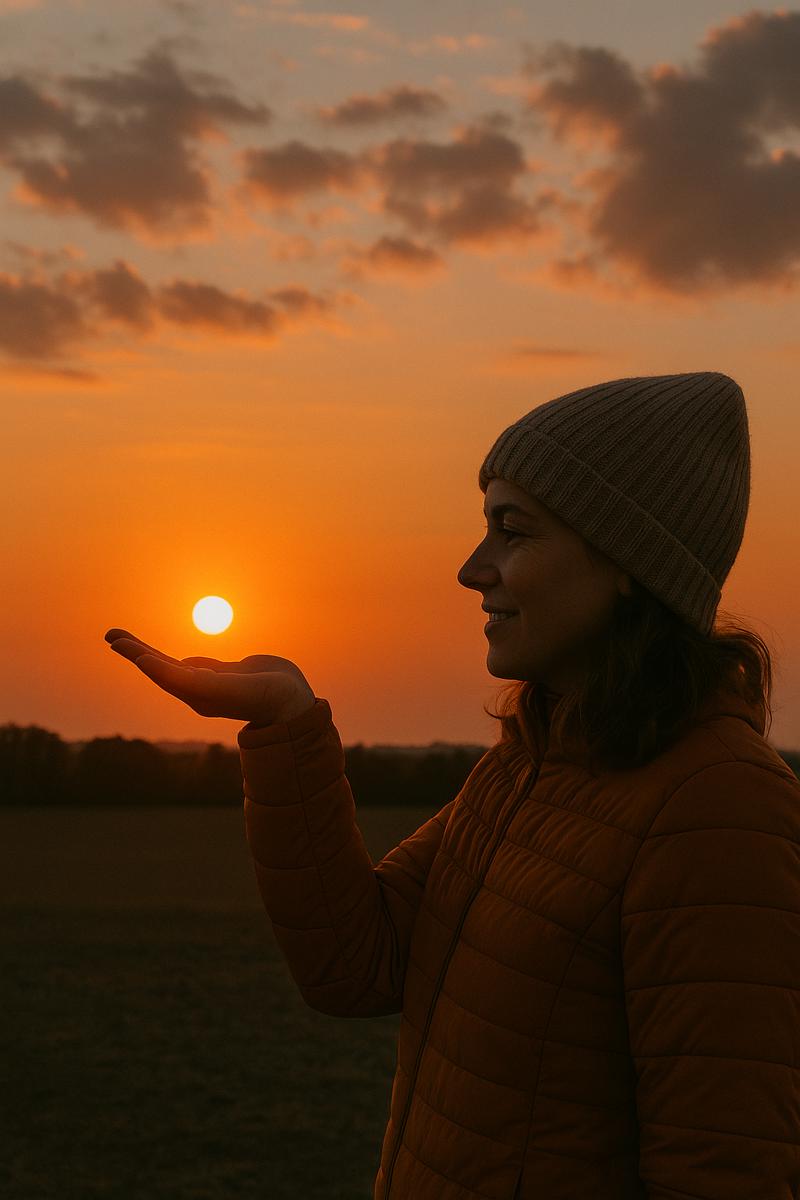
What It Is: Forced perspective is a photographic illusion that plays with scale and distance – making a close object appear huge compared to a far object, or vice versa, through clever positioning. Essentially, it manipulates size and distance to create an optical illusion of depth or scale 4 . Common examples: a person “pinching” the moon or holding up the Leaning Tower of Pisa in the distance. In art and AI images, using forced perspective can result in whimsical, mind-bending visuals that engage viewers as they figure out the trick.
How to Prompt It: When prompting, describe two or more objects/subjects in such a way that one is very close to “camera” and another is far, creating the illusion. Key phrases might include “looks like ... is holding ...,” “perspective trick,” “optical illusion,” or explicitly “forced perspective.” For instance: “A photo of a woman appearing to hold the setting sun in her hand – forced perspective illusion.” In this prompt, we outline the classic forced perspective scenario: the woman’s hand is close to the camera, and the sun on the horizon is far, but aligned to look as if it’s in her palm. Mentioning “forced perspective illusion” can help models like Stable Diffusion recognize the intent (SD has likely seen that phrase). Hi-Dream may not require the exact words but describing the action (“appearing to hold the sun”) is usually enough; Hi-Dream tends to produce artistic interpretations, so you might get a surreal but correct composition. Flux will likely render a highly realistic version (a real-looking photo with proper lighting). Flux is quite good with perspective and spatial relationships due to its advanced training – it might really nail the effect if the prompt is clear. With SDXL or SD3, you have more room in the prompt to describe the scene thoroughly (which helps), whereas SD1.5 might need concise clarity due to its smaller context. Another example: “A tourist at the foreground pinching the top of a distant Eiffel Tower between their fingers, as a playful perspective trick.” This describes both elements (tourist’s fingers close-up, Eiffel Tower far) and the outcome (the tower looks tiny and pinched). The language “distant Eiffel Tower” and “perspective trick” guides the AI to arrange the scale accordingly.
Tips & Troubleshooting: Achieving perfect forced perspective in AI might need a few tries. Tips to help: - Be very explicit about sizes and distance: Use words like “tiny” for the far object and “giant” (or “close-up”) for the near object if appropriate. E.g. “a tiny boat in the distance sits on a man’s open palm close-up.”
Describe the alignment: phrases like “appearing to,” “as if,” “illusion of” can clue the AI that it’s a trick, but sometimes just literally describing the layout works best (like “person’s hand is near the camera, framing the sun”). - Camera perspective cues: You can add “wide-angle” or “near lens” if the model knows those terms, to exaggerate perspective. Also mentioning the type of shot (e.g. “photograph”) may push it toward a realistic perspective rather than a collage.
Model notes: Hi-Dream might occasionally “merge” the two subjects incorrectly if it gets confused – if your forced perspective idea comes out weird (like the person actually touching the sun literally), try removing the “forced perspective” phrase and just describe the positions. Alternatively, add “optical illusion photograph”* to reinforce the concept. Flux should handle clarity well, but if it’s too realistic it might also try to make it physically accurate (which forced perspective is not!). Ensure your prompt implies it’s intentional. Stable Diffusion (especially older versions) could produce artifacts or two disjointed parts of the image. If the alignment is off, try a simpler concept (maybe start with a very well-known one like holding the sun or pinching a building, which the model likely saw during training). For SDXL, you can afford a longer prompt: describe the scene in detail (background, foreground, what the trick is) – it often yields a surprisingly correct illusion.
Why It Works (Visual Impact): Forced perspective images are immediately fun and engaging because they mess with our sense of reality. Viewers see a seemingly impossible scale relationship and usually do a double-take. It adds a story: we know logically “the sun isn’t literally in her hand,” so we understand it’s a playful trick – the image tells a little joke or surprise. This can convey whimsy, creativity, or a sense of wonder. Technically, forced perspective guides the viewer’s focus between the foreground and background, adding depth. In AI-generated art, using this technique makes your images stand out as clever and imaginative, almost like practical magic captured in a photo. And since it’s rooted in real photography tricks 4 , it’s a proven way to make static images dynamic and conversation-worthy.
Atmospheric Perspective (Depth via Haze, Fog, and Color Gradients)
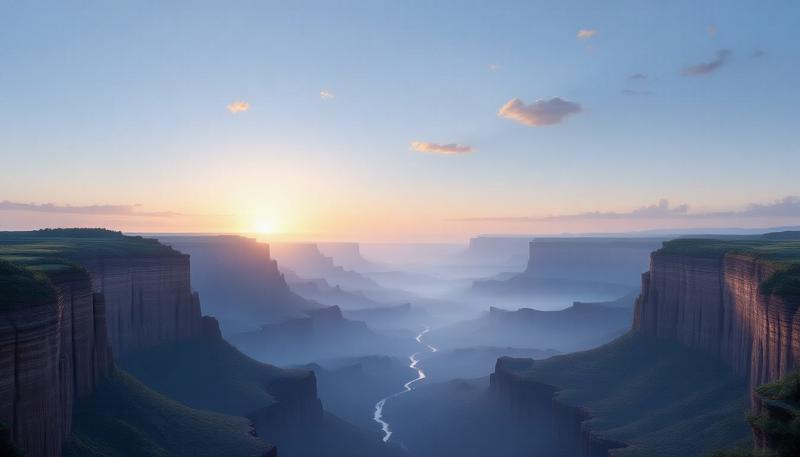
What It Is: Atmospheric perspective (also known as aerial perspective) is a classic art technique to create depth by simulating how the atmosphere affects distant objects. In real life, the farther things are, the more air (haze, dust, moisture) is between them and us – making distant objects fainter, hazier, and often bluer or less saturated 5 . Think of mountains on the horizon looking pale blue compared to the sharp, contrasty trees in the foreground. Using atmospheric perspective in an image means deliberately having distant background elements fade out with fog or color shift, which makes the scene look deep and three dimensional.
How to Prompt It: To prompt this, include descriptions of haze, fog, mist, or fading colors for distant scenery. For example: “A vast canyon at sunrise, with the nearest cliffs dark and detailed, and far distant cliffs disappearing into a light blue mist.” This prompt explicitly sets up depth: “nearest cliffs... detailed” vs “distant cliffs... into mist.” All AI models can pick up on keywords like “haze”, “misty”, “foggy”, which usually cause the generation of fog in the distance. Stable Diffusion (esp. 1.5) might need encouragement to not make everything equally sharp – but words like “distant” and “fading” help. SDXL will likely handle “distant cliffs in mist” quite literally and give you that layered depth. Flux, known for photorealism, will excel if you phrase it like a photograph: e.g. “photograph of mountains with atmospheric perspective, distant peaks faded by fog.” Flux is designed for high quality, so you’ll probably get gorgeous realistic depth and haze. Hi-Dream models may stylize the effect (maybe a dreamy foggy landscape) – using terms like “ethereal haze” or “soft fog” could align with Hi-Dream’s aesthetic for a very atmospheric vibe. Another example prompt: “A dense forest receding into the distance, where the closest trees are rich green and detailed, and the farthest trees are just silhouettes in a pale mist.” This directly tells the AI to apply atmospheric perspective – near vs far difference. Including color shift cues (“rich green” vs “pale”) and words like “in a pale mist” signal how distant things should look.
Tips & Troubleshooting:
Use depth keywords: Include “in the distance,” “far-off,” “on the horizon,” etc., to make clear which elements are far away.
Haze and color words: Words like “hazy, foggy, misty, smoky, atmospheric haze” are your friends. You can also mention “faded” or “muted” for distant colors. For instance, “distant mountains in bluish haze” directly invokes that blue shift that happens with atmospheric distance 5 .
Lighting/time of day: Sunrise or sunset in prompts naturally introduces atmospheric effects (like golden haze or reddish tint far away). If you say “morning fog” or “dusk haze,” models will incorporate that. - Model considerations: Stable Diffusion sometimes makes the whole image uniformly foggy if you overdo “fog” in the prompt. To avoid losing the subject in fog, specify which part is foggy (e.g. “foggy background” or “ground fog far away”) rather than just “foggy photo.” SDXL can understand more nuance, so you can say “clear foreground, foggy background” and it should split the difference. For Hi-Dream, if you want a strong depth effect, consider adding an art style known for depth (like “matte painting” or “landscape concept art”), but it’s optional. Flux will likely do it without extra style prompts – just ensure the prompt is clear which parts get haze. If Flux images come out too crystal-clear (because of its photoreal clarity), you might add “distant haze” or even reduce contrast via prompt (like “distant elements low contrast”).
Negative prompt idea: If the model keeps everything sharp (some models love detail everywhere), you could negative prompt things like “no depth, flat image” or more directly “sharp focus in background” to try to enforce a bit of blur far away. But usually just positively prompting the haze works.
Why It Works (Visual Impact): Atmospheric perspective immediately adds realism and depth. The viewer’s eye can tell what’s near and far, giving a layered 3D feel on a 2D image. Emotionally, misty distant elements can create mood – mystery, calm, or loneliness, depending on context. A landscape with rolling hills fading into fog feels vast and perhaps melancholic or peaceful. This technique also helps direct focus: the subject in the foreground can be bold and detailed, while the background literally fades away, not competing for attention. In storytelling, atmospheric perspective can symbolize uncertainty or the unknown in the far distance, or conversely, emphasize how clear and present the foreground subject is compared to a dreamy background. It’s a subtle but powerful trick used in painting for centuries to convey distance 5 , and your AI images can benefit from the same principle simply by adding a few well-chosen prompt words.
Shadow Play & Silhouette Contrast (Storytelling with Shadows)
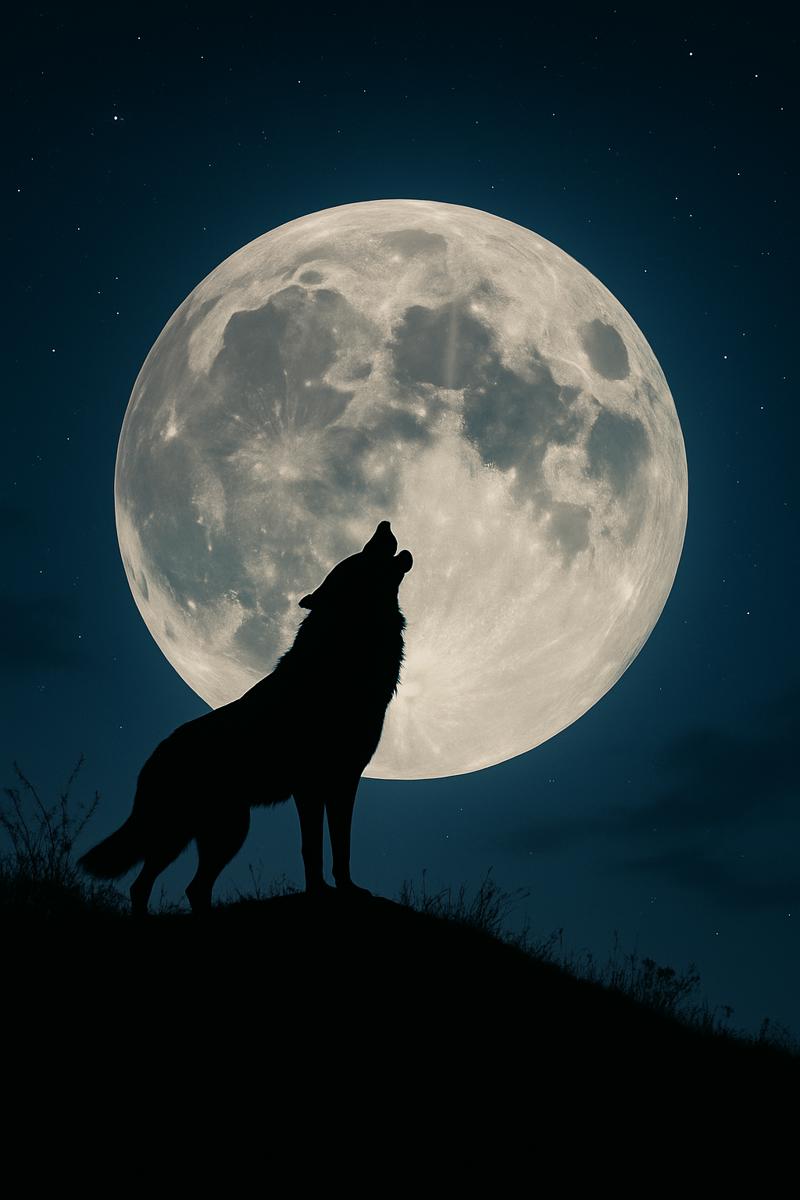
What It Is: This technique uses shadows and silhouettes as key compositional elements to tell a story or create drama. Instead of seeing details of the subject, you might see only their dark outline (silhouette) against a bright background, or you notice the shape of a shadow casting something interesting. Shadows can form images of their own (sometimes different from the actual object casting them), and silhouettes create strong contrast that can be very emotional or symbolic. Think of a person’s silhouette at sunset – we read their posture and context to feel the story. Or imagine the shadow of an object revealing something hidden (like in some clever photos where a harmless object’s shadow looks like a monster).
How to Prompt It: To prompt silhouettes, mention backlighting and the word “silhouette.” For example: “A lone wolf howling on a hilltop, seen in silhouette against a full moon in the night sky.” Here “in silhouette against a full moon” tells the AI the wolf should be dark with the bright moon behind. Most models understand “silhouette” and will produce a dark shape with minimal detail. Stability AI models handle this fairly well – SD1.5 might still try to put some detail, but SDXL especially will nail a true silhouette if asked. Hi-Dream could give a very artistic silhouette (maybe a stylized one with smooth outlines and beautiful sky colors) because it’s good at dramatic compositions. Flux should produce a realistic photo-like silhouette of a wolf on a hill, given its strength in lighting and photorealism. For shadows specifically, you can describe the shadow and the subject relationship. For example: “A small kitten stands in a beam of light, but its shadow on the wall is a giant roaring lion.” This prompt explicitly asks for a shadow that looks different (kitten vs lion shadow). It’s a bit fantastical, but many models have seen similar metaphorical images (it’s a popular concept art idea). The wording “its shadow on the wall is a giant roaring lion” is crucial – it tells the AI to draw that contrast. Stable Diffusion might need a couple tries to get a clear kitten with a lion-shaped shadow, but SDXL’s improved understanding could handle it. Hi-Dream likely finds this an inspiring artistic scene and might produce a beautiful, slightly abstract version. Flux, focusing on realism, might struggle only because a kitten’s shadow realistically wouldn’t become a lion – but since we said it clearly, it may still do it in a semi-real style (like a composite that looks like a clever photo). Another simple silhouette prompt: “Silhouette of a couple under an umbrella, standing before a bright neon billboard at night.” That would yield two dark figures (no details) with a bright background, creating a moody contrast.
Tips & Troubleshooting:
For silhouettes: Use phrases like “silhouette of [subject]” or “[subject] in silhouette” and mention the light source behind them (sunset, bright light, moon, lamp). Also, words like “backlit” help: “a backlit dancer, appearing only as a silhouette.”
For shadow storytelling: It can be tricky, but describe the shadow explicitly as its own entity. The kitten/ lion example did that. Another example: “the shadow of a monster’s claws on the floor, but the actual source is just a playful kitten” (this might be too complex for AI, but you get the idea – describe both the object and the shadow). If the model doesn’t get it, you might focus on just describing the shadow outcome: “a shadow on the wall of a fierce dragon, cast by a tiny lizard in front of a lamp.” That clearly separates the real small object and the large shadow shape.
High contrast: Emphasize contrast in your prompt: “high contrast lighting, dark silhouette, bright background” to ensure the model knows the exposure difference.
Model quirks: If Stable Diffusion gives you a semi-transparent silhouette or starts filling in details, you might need to force it in negative prompt with things like “no facial features” (for a silhouette face) or “only outline, no interior detail.” Hi-Dream often naturally creates pretty silhouettes if you mention sunset or dramatic lighting – but if it adds unwanted fill, use more direct language like “pure silhouette” or even style references like “reminiscent of shadow puppetry” for inspiration. Flux will handle realistic shadows well – if you want a crisp shadow, specify “sharp shadow” or if you want a softer, eerie vibe, “long shadows” at a certain time of day.
Experiment with light sources: Shadows get longer and more dramatic at sunrise/sunset (golden hour) or from single light sources like street lamps. You can include such context: e.g. “under a streetlight, their shadows stretch on the pavement.” This adds narrative (maybe a noir look) and helps composition.
Why It Works (Visual Impact): Shadows and silhouettes evoke mystery and drama. A silhouette leaves out details, which invites the viewer to project imagination onto the subject – this can heighten emotional impact because the scene becomes more universal or symbolic (e.g., two lovers in silhouette could be any couple, making it easy to emotionally connect). The high contrast of a dark shape against light immediately draws the eye and creates a strong focal point. Shadows can carry hidden meanings; as in our kitten and lion shadow example, the shadow tells a “bigger” story than the subject itself. This engages viewers to interpret what’s happening, adding a narrative layer. In essence, using shadows creatively can tell a story indirectly – a very powerful technique without needing extra elements. Compositionally, silhouettes also simplify an image, often creating beautiful clean lines and forms that are visually striking. All this using just prompt words like “silhouette” or “shadow of …” – it’s a straightforward way to get impactful, story-rich images.
Gestalt Principles in Composition (Closure, Continuation, Figure Ground Illusions)
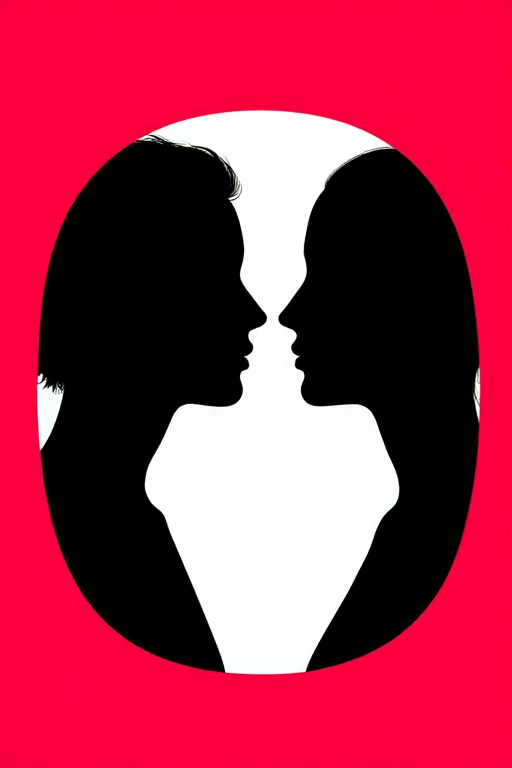
What It Is: Gestalt principles are about how our minds perceive whole shapes and patterns from parts. In visual art, they can be used to create optical illusions or satisfying designs. Three interesting ones for prompting: Closure (our brain fills in missing pieces to see a complete shape), Continuation (our eyes follow lines or curves, seeing a continuous flow), and Figure-Ground illusions (we can flip between two interpretations of what is subject and what is background – e.g. the famous vase/faces illusion). Using these in AI image prompts means you try to create images where either something is only partially there but perceived as whole, or where an illusion/double-image might occur.
How to Prompt It: Admittedly, this is advanced and results can be hit-or-miss, but you can attempt known illusion scenarios. For figure-ground, the classic is Rubin’s Vase: two face profiles making a vase shape between them 6 . A prompt example: “Optical illusion: two black silhouetted faces in profile on either side facing each other, and the space between them forms the shape of a white vase.” This explicitly describes the figure-ground trick. Stable Diffusion (especially SDXL) might produce something reminiscent of that well known image if you prompt it clearly. Mentioning “optical illusion” and “forms the shape of a vase” guides the AI. Hi-Dream might stylize it but could capture the essence since it’s a high-level concept – possibly better to be very literal in the prompt for Hi-Dream as well, or even add “in the style of an optical illusion illustration”. Flux, being photorealistic, might not be the best for graphic illusions like this (it’s more tuned to realism), but you could still try – or use Flux for a more photographic illusion (e.g. a forced perspective or shadow illusion, which are physical types of gestalt play). For closure, you could prompt something like: “An outline of a circle made of broken dashes of paint, not fully connected, yet the mind sees a whole circle.” Or “a panda drawn only with a few black patches on white – an example of closure (like the WWF logo style).” The model might recall the WWF panda logo since it’s famous – you might actually get a panda shape with missing pieces. Using the word “logo” or “minimalist drawing” could help here, because often closure is a graphic design thing. For continuation, you might emphasize flowing lines: “A series of curved lines that lead the eye in a smooth path across the image, continuing from one element to the next.” That one is more abstract – you might instead incorporate it in a scene: “winding road leading the viewer’s eye from the foreground to a distant mountain” – that’s continuation in composition (leading lines). That prompt would result in an image where a road acts as a continuous path (a bit simpler than pure abstract continuation). In essence, many uses of leading lines or aligning elements can demonstrate continuation.
Tips & Troubleshooting:
Opt for known examples: If you want a figure-ground illusion, use the vase/faces or other known ones (like “silhouette of a saxophone player that also looks like a woman’s face” – another classic illusion). Spell it out as in “looks like ... also looks like ...” in the prompt.
Use simple, graphic terms: “black and white illustration, optical illusion” are useful keywords when attempting these, because many gestalt illusions are in simple high-contrast graphic form.
Be prepared for weird results: The AI might merge things oddly or not quite nail the illusion. It’s okay – sometimes you get a happy accident that still looks cool, even if not a textbook perfect illusion. If it’s important, consider simplifying: e.g. just do “two faces as silhouette profile” without the vase part – you’ll at least get the faces; then maybe negative prompt “eyes, noses” if you get too much detail rather than a solid silhouette.
Continuation (leading the eye): To encourage that, include elements like “leading lines,” “curving path,” “spiral composition,” etc., in your prompt. The AI may not understand “leading lines” as a term, but describing the actual thing (like the winding road or “railway tracks converging toward the horizon”) will naturally create continuation.
Model behavior: Hi-Dream can be quite creative and might spontaneously create artsy gestalt-like images if prompted abstractly (e.g. “an abstract pattern that forms a hidden image of a face” might yield something intriguing). Flux might not be the go-to for flat graphic illusions, but you can leverage it for real-life gestalt effects (like the perspective or shadow tricks we discussed). Stable Diffusion’s knowledge base likely includes common optical illusions, so explicitly referencing them can work. Even the word “gestalt” or “figure-ground illusion” could trigger some learned examples – though results vary. It’s always a good idea to check results and iterate your wording.
Why It Works (Visual Impact): Gestalt-based compositions engage the brain on a deeper level. When viewers realize an image has a “hidden” second image or that their mind is completing something that isn’t fully drawn, it creates an aha! moment. This interactivity – the viewer actively interpreting and completing the image – can make the artwork more memorable and fun. For instance, the faces/vase illusion 6 makes people switch back and forth, marveling at how one picture can be seen two ways. Using closure (like the broken circle or panda idea) can create a sense of stylistic cleverness; it looks minimalist but feels complete. Continuation leads a viewer through the scene, which is visually satisfying and naturally storytelling (e.g., a road or a leading line can imply a journey or passage of time). These principles come from psychology and design, so they’re proven to impact how we experience visuals. In AI-generated art, including hints of these concepts can elevate your image from just a picture to a little puzzle or story for the mind. It invites viewers to spend more time with the image, discovering the trick or following the visual flow, which is exactly what intermediate storytellers want – deeper engagement through composition.
Narrative Tension Through Visual Opposition (Spatial Conflict & Visual Drama)
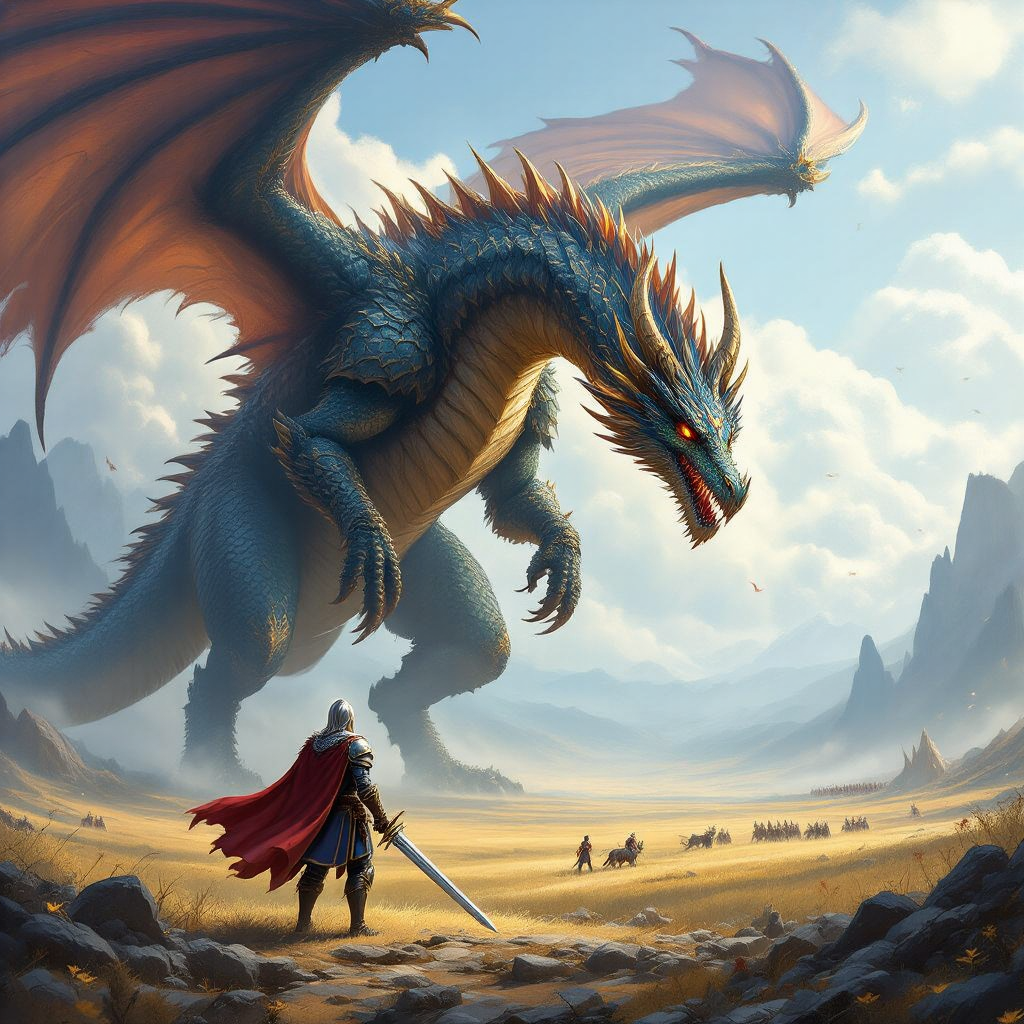
What It Is: This is about setting up a scene with contrasting elements that appear to oppose or conflict with each other, creating tension in the image. Visual opposition can be achieved through differences in size, position, or concept: e.g. a tiny character facing a huge monster (big vs small), or two subjects on opposite sides of the frame glaring at each other (spatial opposition), or even contrasting imagery like a flame and a wave about to collide. By having two opposing forces or elements, you build an implicit story of conflict or drama in the viewer’s mind.
How to Prompt It: Think of two things that naturally have some conflict or contrast, and place them in one scene with a sense of standoff or imbalance. For example: “A single small knight stands on one end of a vast battlefield, staring up at a giant towering dragon on the other end, both poised to fight.” This prompt explicitly sets a David vs Goliath scenario. We mention the small knight and the giant dragon opposite each other. The AI will likely compose it with the knight in foreground and huge dragon in background, or opposite sides – either way, you get the idea of confrontation. Stable Diffusion will handle this kind of narrative scene well, especially if you include details like environment (battlefield) to ground it. SDXL can follow the “one end... other end” phrasing better than older SD which might clump them together. Flux will produce a dramatic, realistic interpretation – possibly very cinematic. Flux tends to do well with action/fantasy if described; you might get a movie-like shot of a tiny knight vs a dragon with great lighting (just ensure to describe it in visual terms so it doesn’t miss the scale: “tiny knight” and “towering dragon” are good cues). Hi-Dream could stylize it into a fantasy art piece, which might be fantastic for this scenario – maybe leaning into dramatic colors or perspective. Another angle: “In a split composition, on one side a thriving green forest, on the other side a barren desert, meeting in the middle in stark contrast.” This is visual opposition in an environmental/storytelling sense (life vs death, abundance vs scarcity). Prompting it as “split composition” or “on one side... on the other side...” tries to guide the AI to divide the image. You could also do it with characters: “Two friends stand back-to-back, one in bright light and one in shadow, illustrating a rift between them.” This uses light vs dark as opposition to symbolize conflict.
Tips & Troubleshooting:
Emphasize contrast: Use adjectives that exaggerate the differences (small vs gigantic, light vs dark, rich color vs desaturated, left vs right). This helps the model not muddle the two elements together.
Positioning hints: Words like “opposite each other,” “at opposite ends,” “facing each other,” “back to back,” etc., will create spatial separation or confrontation. If you want them separated in frame, you can even say “one on the far left of the image, the other on the far right”. Models don’t always perfectly obey left/right, but it can instill the idea of separation.
Use environment to support tension: If it’s a conflict, describing the environment can amplify it (stormy sky, cracked ground between them, etc.). These details add drama. For example, “under a stormy sky, a tiny boat fights against a giant wave” – the stormy sky and giant wave double down on the peril.
Model nuances: Stable Diffusion sometimes loves centering subjects; to maintain tension, you often don’t want symmetry – you want imbalance. So, if SD centers them in a friendly way, try rephrasing to enforce the distance (like “tiny figure in extreme foreground, huge creature looming in background” or use “versus” in the prompt: “knight versus dragon” which hints at a face-off). Hi-Dream might naturally produce a dramatic composition (it’s good at mood), but if it makes it too harmonious, lean into conflict words: “threatening,” “versus,” “tense,” “dramatic lighting.” Flux will likely produce realism – if it’s too calm, you might need to add “intense” or “dynamic pose” etc., to get that sense of action. Also ensure your prompt clearly indicates conflict (like weapons drawn, or aggressive posture) so the AI doesn’t make them just chatting!
Symbolic opposition: You can be creative – it doesn’t always have to be two characters. It could be elements like “fire and water”, or concepts like “youth and old age” personified by two people, etc. For those, describe them clearly: e.g. “an elderly man and a young boy sit on opposite sides of a bench, not looking at each other, highlighting the distance between generations” – a quieter tension, but still a narrative in one frame.
Why It Works (Visual Impact): Conflict draws interest – when we see two opposing forces, we immediately wonder about the story: Why are they in conflict? Who will win? Visually, opposition creates dynamic tension: it can make an image feel alive and unstable in a good way. Unlike a balanced, peaceful composition, a deliberately off-balance one can make viewers a bit uneasy or excited, keeping their attention. Placing elements at opposite ends or dramatically different scales makes the image less comfortable and more engaging (the eye bounces between the two, creating energy). This technique is commonly used in movie posters and illustrations to convey drama at a glance – and it works just as well in AI art. It’s essentially visual storytelling: you don’t need a whole sequence to show conflict; a single frame with the right opposing setup lets the audience feel the tension. The key is that the spatial arrangement itself (far apart, one looming over the other, etc.) communicates the relationship. This is a prompt-only way to get storytelling in your image without needing text or multiple panels – the conflict is frozen in that one image, and that invites the viewer to imagine the before and after.
Light Temperature Contrast (Mixing Warm & Cool Light for Mood Shifts)
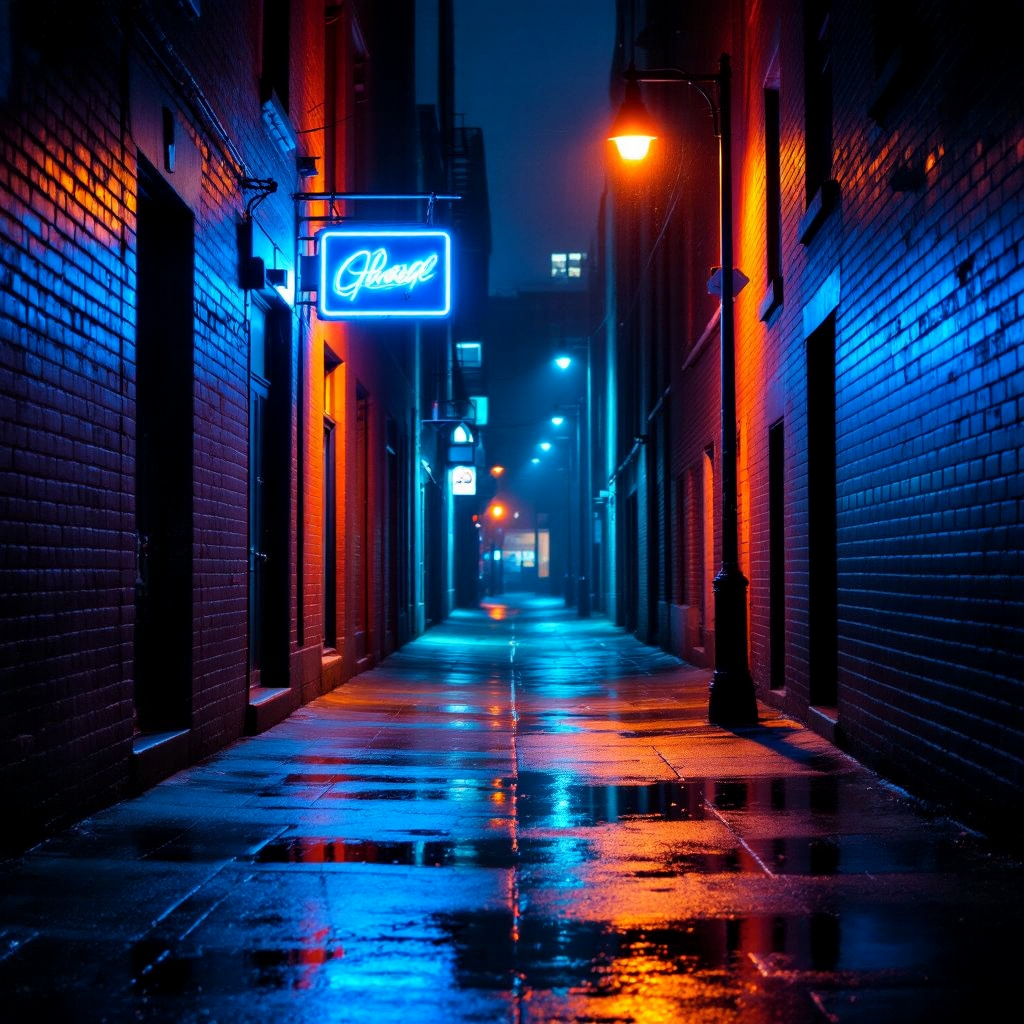
What It Is: Light temperature refers to the color of light – warm light (yellow, orange, red tones like candlelight or sunset) versus cool light (blue tones like moonlight or overcast daylight). Using both warm and cool lighting in one image creates a strong contrast that can be very visually appealing and also emotionally suggestive. For example, a scene lit half by a golden sunset and half by blue shadows has a cinematic feel, or a room with a cool moonlight coming through the window but warm firelight on the subject creates a rich mood. Warm light tends to feel cozy, lively or tense (depending on context), and cool light feels calm, futuristic or sad. Combining them can produce a dramatic mood shift within the image – essentially two color atmospheres in one scene, which guides the emotional response.
How to Prompt It: Mention two light sources or areas with different color lighting. For instance: “A nighttime alley scene illuminated by a mix of neon blue light from a sign and warm orange light from a streetlamp, casting both cool and warm tones on the wet pavement.” In this prompt we clearly have blue and orange lights interacting. The AI will likely produce a visually striking color contrast (blue vs orange is a classic combo, often seen because they are complementary and create strong contrast 7 ). Stable Diffusion models respond well to color cues like “neon blue” and “warm orange glow”. SDXL in particular will understand multiple light sources better than older SD, so you might get distinct colored lighting. Flux, with its photorealism, will produce a very believable lighting scene – you might actually see the orange lamp and blue sign light reflecting on surfaces. It handles subtle lighting well, but if you want to ensure the contrast is obvious, be explicit (like the prompt above did). Hi-Dream might stylize the colors a bit extra (which can be beautiful), possibly giving a dreamy saturated look to blues and oranges. If you prefer a specific model’s bias, you can lean into it (e.g., Hi-Dream loves neon cyberpunk scenes, so it will shine with a prompt about blue and pink neon with warm backlighting, etc.). Another example: “Portrait of a woman by a window at dusk – cool blue moonlight comes through the window onto one side of her face, while warm golden candlelight illuminates the other side.” This describes a classic warm-cool split lighting on a subject. It’s almost a half-and-half lighting scenario. Models should grasp it: the mention of two colored lights on different sides of the face is a strong directive. For even clearer prompt, you could say “her left side lit by orange candle glow, right side lit by blue moonlight” though left/right might or might not be followed precisely.
Tips & Troubleshooting:
Name the light sources: It often helps to actually mention what is producing the light, as in the examples (neon sign, streetlamp, candle, moon). This makes the scenario concrete and the model will usually render the colors accordingly (candle = warm amber light, moon = pale blue light, etc.).
Use color adjectives: Don’t shy away from stating the colors: “cool bluish light,” “warm golden light,” “red glow,” etc. The phrase “warm and cool colors in the same image” might even work since these are common concepts 7 , but better to be specific.
Placement words: If you want a certain effect like warm foreground cool background, say that. E.g. “warm light in the foreground, cool misty bluish light in the distance.” Or warm key light, cool fill light in photography terms (though that might be too jargon-y for some models).
Intensity and balance: You can adjust the mood by how much of each. “Mostly cool lighting with a splash of warm light from a fireplace” or vice versa. The model will then allocate more of one tone. Also, adjectives like “soft” vs “harsh” light can change feel (soft warm light might feel cozy, harsh warm light might feel like intense sunset heat).
Model specifics: Stable Diffusion 1.5 sometimes skews images towards one color (especially if you use a strong color word). If your image comes out too blue overall, try emphasizing the warm source more, or vice versa. You might even need to explicitly ask for contrast: “blue and orange complementary lighting” (since blue/orange is a known appealing combo in art 7 ). SDXL will likely give a nice balance if you described it. Hi-Dream is generally vibrant; if it oversaturates too much, you can add “cinematic lighting” which tends to imply a nice balance of warm/cool tones without going cartoonish. Flux being realistic, if it’s too subtle with the colors (maybe it white balances them), you might push it by saying “dramatic colored lighting” or mention time of day (dusk plus artificial light ensures mixed temperatures).
Negative prompt: If you keep getting, say, only one color cast, consider negative prompting that color when it’s not supposed to dominate. For example, if the whole scene goes orange, negative prompt “monotone orange” or “orange tint” to force it to bring back the blue.
Why It Works (Visual Impact): Mixing warm and cool light is a staple of dramatic photography and cinema because it immediately creates visual contrast and depth. Human eyes are drawn to warm colors, but the juxtaposition with cool makes both pop more. It can also signal different zones in the image – for instance, a cool background can make a warmly lit subject stand out strongly (or vice versa, a warm light behind a cool subject outlines them). Emotionally, as studies in color psychology and cinematography show, warm vs cool lighting influences mood 8 7 . Warm light often conveys comfort, energy, or danger (think fire, sunset, alerts) while cool light can mean night, calm, technology, or sadness. When you have both, you create a complex mood: perhaps conflict (e.g. a character half in warm light, half in cold light could symbolize inner turmoil or moral ambiguity), or simply a more lifelike atmosphere (most real scenes have multiple light sources of different temperature). In storytelling, you can use this to subtly cue the viewer: imagine a scene of a detective (cool light from a window on him, but warm light from the crime scene evidence illuminating his face – a visual metaphor for logical cold thinking vs the warmth of human truth or emotion). All in all, it makes images more engaging and “professional” looking, as photographers often purposely play with white balance differences to create that blue-orange cinematic look 7 . With prompting, it’s an easy way to add instant mood and polish to your AI images.
Frame-within-Frame Repetition (Nested or Recursive Framing)

What It Is: This composition trick involves using elements in the scene to create a “frame” around the subject, essentially having a frame inside the picture’s frame. Examples: shooting a subject through a doorway, window, or arch which forms a border around them; or having an overhanging tree branch circle the top of the image like a frame for what’s beneath. “Nested” or “recursive” framing can also mean multiple layers of frames – like looking through many doorways in a row (each doorway frames the next room). The effect draws attention to the subject and adds depth and sometimes a repeating pattern. It’s a classic way to focus the viewer and make the composition more intriguing.
How to Prompt It: Include an element that naturally serves as a frame and mention the subject is visible through it. For example: “View from inside a cave looking out: the dark cave opening forms a frame around a bright beach scene outside where a person stands.” This prompt tells the AI the cave opening itself is a frame within the image (dark edges of the cave mouth framing the person and beach outside). Stable Diffusion and others will likely put a black vignette of cave walls around and the scene through it. Hi-Dream might make this very atmospheric with nice contrast (it’s good at chiaroscuro elements like that). Flux will produce a highly realistic cave interior with that bright exterior – you’ll get a real sense of being inside looking out. Another prompt: “A photo of a woman seen through a rainy window frame; the window panes and sill create a frame around her figure.” That explicitly says we’re seeing the subject through a window frame. The AI should place window borders in the composition with the woman behind them. You can also do more abstract recursion: “an infinite hallway of arches one after another, each arch framing the next, with a figure at the far end.” That describes a repeated frame (arches) giving perspective depth and drawing your eye in. Words like “each arch framing the next” will hint the model to do a nested pattern. SDXL can handle these recursion ideas quite well. SD1.5 might not make it infinite but maybe a couple arches. But even a single archway with the subject at the center can work as frame-in-frame.
Tips & Troubleshooting:
Use “through” and “framed by”: Phrases such as “seen through [object],” “framed by [object]” are great to literally tell the model the concept. For instance, “portrait framed by autumn leaves” or “seen through a circular mirror.”
Be specific about the frame object: If it’s a window, door, arch, curtain, tree branches, etc., name it. The model will then include that object in foreground as a frame. E.g. “looking out of a window” or “under an archway”.
Lighting can help: Often the frame (like the cave or a doorway) will be darker and the beyond is lighter, naturally framing the subject. You can encourage this by mentioning “dark silhouette of cave opening” or “interior in shadow, outside bright.” This not only frames but adds contrast making the frame obvious.
Avoid confusion with actual picture frames: If you just say “frame”, sometimes the model might think of an actual photo frame or border graphic. So tie it to the actual object: “window frame, door frame, natural frame of trees,” etc.
Model notes: Most models get this concept readily because it’s very visual and present in photography. If Hi-Dream or others sometimes omit the foreground frame, try a stronger wording like “from inside” (like “from inside a car looking out at...”). That usually forces a frame (the car windows, for example). Flux might produce reflections on glass if you do window, which could either add realism or distract – if too much, you might say “clear view” to avoid window glare. Stable Diffusion might sometimes produce partial frames that don’t fully surround the subject. If you want a complete framing, consider adding “vignette” or “border” in a subtle way (though that might give an artificial border). It might be better to try different frame elements: if “through a keyhole” doesn’t work one time, rephrase or try “through a round porthole” etc., to see if it picks up. SDXL’s greater ability in composition should make it easier – it often places such framing elements correctly when asked.
Nested frames: For multiple recursive frames (like the arches hallway), using words like “repeating” or “series of” can be useful. You might say “a series of arches,” or “multiple concentric frames” for something like mirrors reflecting each other (though mirror reflections get tricky, they often confuse AI). But at least for architecture, it does well: “a corridor of doorways” will likely give that visual repetition.
Why It Works (Visual Impact): Frame-in-frame composition draws the viewer’s eye inward to the subject. The internal frame acts like an arrow or spotlight, saying “look here.” It also adds a sense of depth because you have foreground (the frame) and background (the subject) in one shot. This makes the image more three-dimensional and layered. Narratively, frames can suggest voyeurism or context – e.g. seeing someone through a window makes it feel like a candid or secret moment, adding intrigue. Or looking out of a cave gives a feeling of discovery/adventure (you feel like you’re with the person hiding then seeing the world outside). Repeated frames (like those arches) create rhythm and can symbolize a journey or passage of time/distance (each arch a step further). It’s visually interesting to look at; the eye enjoys patterns and also enjoys when patterns lead to a payoff (the subject at the end). In many great photographs and paintings, you’ll find something in the scene used to frame the main subject – it’s a tried-and-true method to make compositions more compelling. Using it in AI prompts makes your image automatically feel more “composed” and intentional. And it’s fun to experiment with: you can try framing with all sorts of things (trees, tunnels, doorways, even people’s arms forming a circle). The end result is usually an image that feels complete and focused.
Environmental Storytelling (Telling Stories Through Settings & Objects Alone)

What It Is: Environmental storytelling means the scene itself – the background, setting, and objects in it – tells a story without needing any characters or text. It’s like looking at a room or landscape and deducing what happened or what the story is, purely from visual clues. This technique is used a lot in video games and film (think of a wrecked room with broken glass and spilled wine – you know something went down there). In AI art, you can create images where the environment and props imply a narrative for the viewer to piece together.
How to Prompt It: Focus your prompt on the objects and setting, and include adjectives that hint at a story. For example: “An abandoned child’s teddy bear lies on a swing in an empty playground at twilight, the surrounding area overgrown and silent.” This prompt has no people, but it’s rich with story hints: a lone teddy bear (suggests a child was here, and “abandoned” hints at loss), empty playground at twilight (time of day adds mood, overgrown implies long neglect, silence adds to atmosphere). The AI will produce a melancholic scene: likely a playground with a teddy bear on a swing. Hi-Dream could make this quite cinematic and emotional (it’s great at mood, twilight, and soft storytelling details). Stable Diffusion will pick up the key elements (teddy bear on swing, empty playground) – SDXL would likely nail the overgrown grass and lighting nicely. Flux will render a realistic version: you might see a very lifelike teddy and realistic lighting. Another scenario: “A small dinner table set for two with candles burned low and cold, one chair knocked over and wilted flowers on the floor.” No people present, but the details (knocked chair, wilted flowers, burnt-down candles) imply perhaps an argument or something sad happened – it tells a story of an evening gone wrong. When prompting such scenes, choose objects that symbolize the story: e.g., a knocked over chair = sudden exit or conflict, wilted flowers = time passed or neglect, etc. Describe the state of objects: “door left swinging open,” “dusty untouched room,” “half-eaten meal abandoned,” etc. These descriptors cue the AI to set up a scene that makes the viewer ask “What happened here?”
Tips & Troubleshooting:
No characters: If you truly want no people visible, you can add “no people” in the prompt or negative prompt “people, figures” to be sure. Sometimes the AI might try to add a person because many scenes have them, so explicitly state it’s empty or abandoned.
Strong adjectives and object choices: Words like “abandoned, forgotten, recently used, neglected, untouched since…” are powerful. They immediately signal a story (abandoned means someone left it behind, recently used but now empty means someone was just here, etc.). Pair these with specific nouns: “abandoned campsite with a fire still smoking” or “forgotten diary on a table covered in dust”. The juxtaposition of something active (fire smoking, implies recent) with emptiness of people tells a story.
Details, details: Small details can carry big narrative weight. A single shoe on a road, bullet holes in a wall, a gift wrapped box left on a bench. Include one or two poignant details rather than cluttering many. E.g. “bloodstained knife on kitchen counter amid a half-prepared meal” – yikes, we get a whole crime story in one image. Make sure to set the scene context too (a kitchen, lights off, etc., so the AI has a place for that knife).
Lighting and weather for mood: A sunny bright scene with an abandoned object might not feel as sad or dramatic as twilight or foggy weather. So adjust time of day and weather to match the emotional tone. Rain, dusk, fog for somber or mysterious stories; bright daylight if you want an ironic contrast (like a tragic scene under a cheery sun can be haunting in its own way).
Model behavior: Hi-Dream excels at these artsy storybook feelings – you might get very evocative coloring and composition, maybe even a bit of stylization that enhances the mood. Flux will ensure high detail (great for objects and texture – the teddy might look worn, the rust on playground, etc. which are excellent story clues). Stable Diffusion might sometimes add a silhouette of a person even if you said no people, because it’s learned that formula. If that happens and you don’t want any person, increase the weight of “empty, no one, deserted” in prompt or negative prompt “person, child, figure.” If you do want maybe a hint of someone without showing them (like shadows or footprints), you could include that: “footprints in the snow leading away” – which tells a story of someone who left. The model will likely include those instead of an actual person. Use such indirect human traces to your advantage.
Don’t over-explain: Remember, we want the viewer to do a little thinking. So your prompt should set the scene but not spell everything out in text obviously (which it won’t anyway; it’s an image). It’s more about choosing the right elements than it is about quantity of elements. A simple composition with one or two very meaningful objects often works better than a cluttered scene. For instance, one teddy on a swing is more powerful than dozens of toys scattered (unless the story is something like a playtime abruptly ended – but even then a single doll left behind can symbolize all).
Why It Works (Visual Impact): Environments that tell a story invite viewers to become detectives. We naturally start picking up clues: “Why is this teddy bear here alone? Where is the child? Something feels sad or eerie…” It engages imagination more than a fully explicit scene. In a way, it’s showing aftermath or prelude rather than the event, which can be very compelling. This technique also makes the viewer the active participant in the story, which can create a stronger emotional response. Composition-wise, focusing on objects and setting can lead to very poetic, striking images – often minimalistic but rich in meaning. It’s a bit like still life photography except imbued with narrative. By prompting such scenes, you elevate your AI art from just “a pretty picture” to a story encapsulated in a moment. It’s subtle and advanced, because you have to think: “What objects symbolically represent my story concept?” But when it works, it hits hard. A room with just the right props in disarray can say more than a picture of the event itself. And practically, AI is good at rendering environments and props, sometimes more reliably than multiple characters interacting, so this is a great way to convey complex ideas without wrangling the AI to pose people. Environmental storytelling adds depth and re-watchability to your image – viewers might notice a detail the second time and go “Oh, I see what that means!” which is exactly the rewarding experience we aim for in advanced compositions.
Conclusion:
All the techniques above can be achieved with clever wording in your text prompts – no special add-ons needed – and they work across Hi-Dream, Flux, and Stability AI models with minor tuning as noted. To recap, we covered how negative space can evoke isolation, how repetition with a twist draws the eye, using forced perspective and atmospheric haze for depth and illusion, telling stories with shadows and silhouettes, playing with Gestalt illusions for brain-teasing art, creating tension with oppositions, mixing warm vs cool light for mood, adding depth with frames within frames, and leaving narrative clues through environmental storytelling. As you craft your prompts, always consider why a visual trick works – understanding the emotion or perception behind it will help you describe it better. And don’t be afraid to iterate: if the first result isn’t perfect, tweak the phrasing (maybe you need an extra “empty” here or a “dramatic lighting” there). Part of the fun in intermediate prompting is these small adjustments that suddenly make a big difference in composition.
By mastering these techniques, you’ll be able to create AI-generated images that not only look compelling but also feel like they have a story and soul. Happy prompting, and enjoy experimenting with these advanced composition ideas to bring your visions to life! Each successful image will not just be a picture, but a moment or emotion captured – and that’s the real artistry in AI art.
How Can The Use Of Negative Space Amplify The Emotional Impact Of Your Photos? - Shut Your Aperture
https://www.shutyouraperture.com/using-negative-space-to-enhance-photo-emotion/
What prompt is required to have a subject fully in frame using Stable Diffusion based AI image generation? - GenAI Stack Exchange
3 How to Use Patterns and Repetition to Create Stronger Compositions | Contrastly
https://contrastly.com/how-to-use-patterns-and-repetition-to-create-stronger-compositions/
4 Useful Prompts | SeaArt Guide
https://docs.seaart.ai/guide-1/5-practical-examples/useful-prompts
5 Aerial perspective - Wikipedia
https://en.wikipedia.org/wiki/Aerial_perspective
6 What are the Gestalt Principles? | IxDF
https://www.interaction-design.org/literature/topics/gestalt-principles? srsltid=AfmBOoqJi3mgd62Nmkh3O_W6J3UgtMK9Kxzntwk0sxbUAY3a2VzHzKGg
How to Use Warm and Cool Colors in Photography & Lighting





